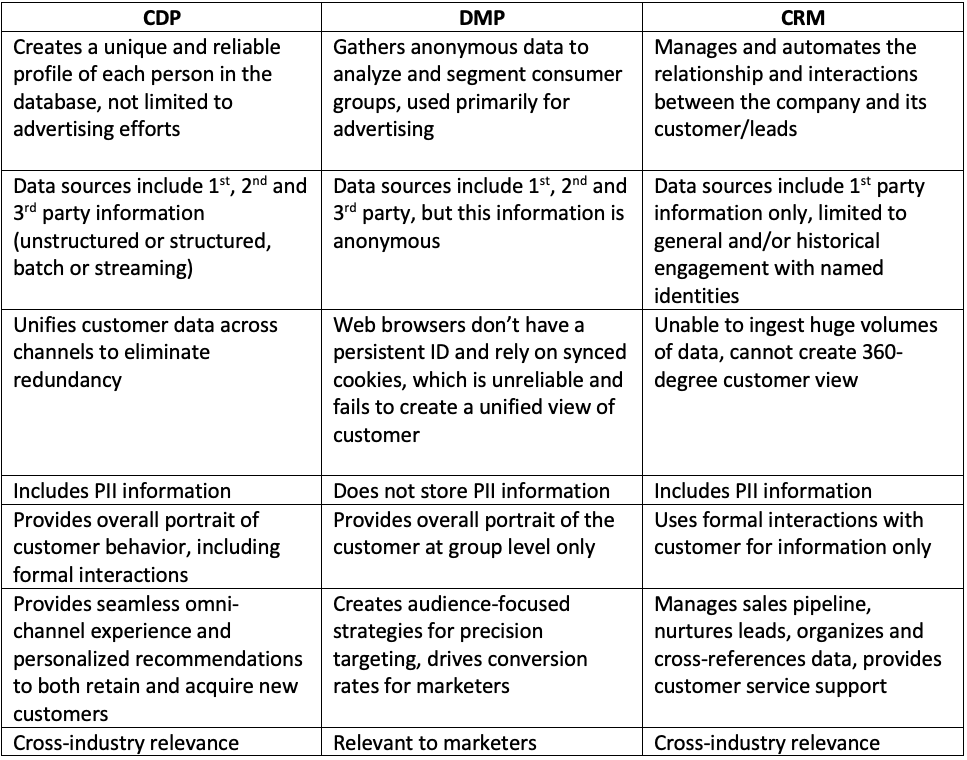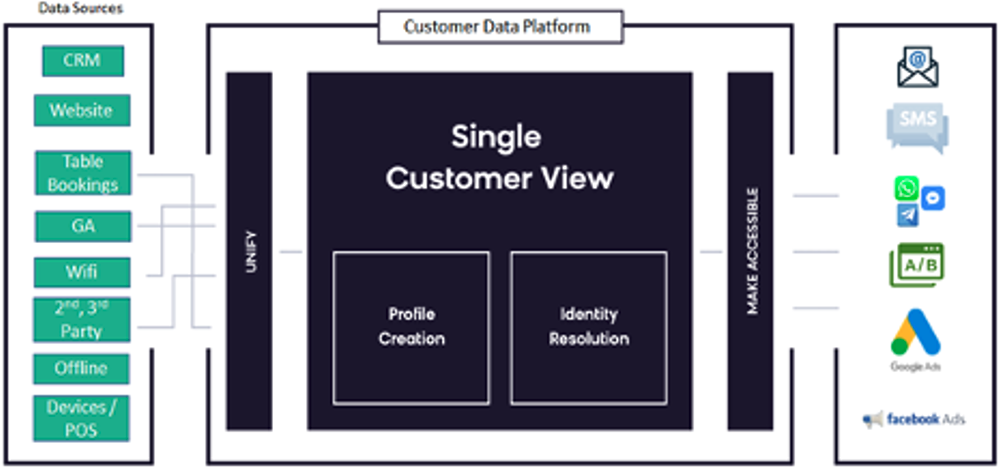
Why CDP is the Foundation for a Customer-First Strategy

The average person may be beyond bored with the ongoing global health crisis, but there is a consensus among business leaders that the pandemic was not only a catalyst for increased digitization but also a key factor in accelerating the demand for next-level customer data insights. And while the continued presence of COVID (and its current variants) has forced us to change the way we work, shop, interact and relax, there is an argument to be made that real-time data and analytics has benefited significantly.
In the last two years alone, for example, brands have been forced to adapt to the digital challenges and pain points that the pandemic brought into sharp focus.
We all remember how the early months of 2020 saw hundreds of millions of people locked down, with an increased focus on digital forms of entertainment, retail, banking and healthcare. In many ways, it was the shift to a more digital mindset by the general public that led to an exponential increase in the amount of data being generated and, unsurprisingly, the brands that weathered the storm were the ones with access to accurate customer data.
For many of these companies, it was access to a Customer Data Platform (CDP) that both kept them afloat and allowed for strategic marketing initiatives. When you factor a rising demand for omni-channel experiences and the importance of real-time data analysis, there is little doubt that the CDP market is primed to take full advantage of our new digital maturity.
With that in mind, let us take a deeper dive into not only what CDP is but also how it can help companies build an effective customer-first engagement strategy.
What is CDP?
Getting actionable insights from customer data is nothing new. You only have to think back to the pre-digital days of Maddison Avenue and the continued use of advertising campaigns that had specific target demographics to understand that companies have always had access to the information that they need.
Data is a commodity, even more so in the connected society that we now inhabit. As more entities digitalize, the value of that information increases.
However, the evolution of the data-rich internet and its associated technologies has raised the bar significantly in terms of when and where information can be learned or used.
This became evident in the late 2000s with the launch of Real Time Bidding (RTB), a tool that allows advertisers to reach audiences on an individual basis over websites and mobile apps. RTB can then provide access to reams of valuable data for companies to mine through integrated solutions.
For example, Data Management Platforms (DMPs) collect data as part of their audience segmentation processes, which companies can leverage in their RTB auction strategies. This evolution has transformed how brands engage with their existing or potential customers, paving the way for CDP to become a major factor in how we collect and analyze data.
According to the Customer Data Platform Institute (CDPI), a CDP is “packaged software that creates a persistent, unified customer database that is accessible to other systems.”
The key elements here are the language used to describe the software itself, with the tool designed to collect data from both online and offline sources. This includes data from a brand’s native properties (websites, apps) and other data platforms (such as CRM, data warehouses, web analytics, social media, 2nd party, 3rd party etc.).
Simply put, companies that incorporate CDP into their business optimization strategies can create a persistent, unified customer database that is accessible to other systems.
CDP, More than a Marketing Tool
A recent op-ed published on CMSwire said that the CDP market is expected to see significant adoption rates in the near future.
To be fair, this is hardly breaking news. A Gartner report from 2019 (cited by the news source) said that 43 percent of respondents already had a CDP system in place and 31 percent were looking to integrate one – with the consensus being that there is a defined need for not only audience engagement but hyper-segmentation of targets.
Fast forward to now and a recently published CDPI blog reveals that the number of brands who had either deployed or planned to integrate a CDP is nearer 90 percent. In addition, that same blog said 75 percent of consumers are willing to pay more for an effective customer experience and 50 percent will move to a competitor after only one negative interaction.
Provided that these numbers remain an accurate reflection of current customer behavior, then it becomes clear a CDP will provide brands with the deeper insights that they need to accurately craft their acquisition and retention strategies accordingly. When you add the application of analytics into the mix, then the prevailing concerns of churn and non-specific marketing efforts become easier to dispel.
For the record, CDP is more than just a marketing tool. When done right, the platform can be a key part of digital maturity, offering companies both a holistic view of customers and the opportunity to deepen the relationship accordingly. Trust is often cited as one of the building blocks of effective customer engagement, and the types of data that a CDP works with – customer attributes, transactions, campaign metrics and customer service – are all part of the overall goal of delivering delight.
In recent months, there has been an increased interest in the software from financial institutions, retail and commerce companies, all of whom are actively investing in the platform – a report by Mordor Intelligence said that the market will experience a CAGR of around 32 percent between 2021 and 2026, for instance. And although CDP is still considered to be an emerging solution in terms of how brands interact with their customer base (both existing and potential), the use of next-gen technology such as cloud, AI and machine learning is boosting market growth.
So, how is CDP different from data platforms such as DMP and Customer Relationship Management (CRM)?
The answer is that the effective integration of this software provides a unified view of all customer data and not just the more siloed views that that can be a feature of non-CDP solutions.
Taking that into account, the table below provides an overview of what each data platform provides and, importantly, where they are deficient:

If we take these various properties and attributes into account, then the features of each data platform (CDP, DMP, CRM) can be broken down as follows:
- CDP: Unified customer data, persistent, packaged system, real-time capability, open access, customer-centricity focus
- DMP: Packaged system, real-time capability, open access, customer-centricity focus
- CRM: Unified customer data (limited), persistent, packaged system, open access (limited), customer-centricity focus
For the sake of completeness, we should also consider the attributes of the data warehouse, albeit that these platforms only tick three of the CDP boxes – unified customer data, persistent, open access.
Enhance Customer-focused Strategies with CDP
There is an oft-cited myth that CDP is designed to replace all existing data platforms (which includes data warehouses) and be the one-stop shop for customer insights or engagement. This is not what CDP was built for.
Rather, the integration of a CDP brings all customer data into one place and essentially stiches together a unified profile of an individual or target audience. Companies can then look at the whole picture and make an informed decision as to what will work best for each part of the customer process.
Every data platform is important, even more so when you consider the value of the data that is generated. For example, DMPs can bring in new prospects and leads, CRMs manage the ongoing relationship between the customer and brands, while the data warehouse supports the company-wide need for accurate reporting and connected intelligence. What CDP does is unify the information into a single source of truth.
The real value of CDP comes in how it not only creates a single view of the customer but also provides the data-specific answers that companies are constantly looking for. These include but are not limited to questions such as:
- Which customer segment or cluster does this customer belong to?
- What was the last purchase made by this customer before his / her current purchase?
- Is this customer likely to churn?
- Did he / she respond to the promotions we had done in the last one year?
- What are his / her preferences and where are they in the customer journey mapping?
- What is their purchase intent and the time they are likely to make a purchase?
- What are the preferred touchpoints for interactions and where are they creating so-called moments?
- What is the predicted value of this customer (current and future)?
All these questions are the bedrock of any successful customer engagement strategy.
When you incorporate the answers into the holistic 360-degeee view of customers that brands need for trust or relationship building, then a CDP should be able to:
- Create single view of customer (identified & anonymous)
- Identity Resolution from data collected across disparate sources
- Provide real-time segmentation and smart decisions with relevant offers
- Influence customer acquisition and retention strategies
- Activation across channels (outbound integration
This can be further illustrated in the visual below:
 View of a proposed CDP
View of a proposed CDP
CDP Capitalizes on Moments
Brands will often talk about the need to establish customer relationships and loyalty through moments.
This concept relates to how we now engage with both the technology around us and the 24/7 nature of the connected society that we live in. As a result of this engagement, it is the growing awareness of digitalization and customer-centricity that are a key part of CDP.
People will constantly have these moments, often centered around seemingly fragmented interactions via digital media channels and portals – checking the time, texting, social media, ecommerce browsing etc. For most of us, these measurable moments occur when we are looking to buy something, look something up or want to go somewhere. All these touchpoints generate data. And it is that information that provides the building blocks for customer relationships that CDP taps into.
In some ways, this is a two-way street; consumers can engage with the brand, which then allows said brand to gain insights into how they are perceived and, crucially, through which channel. Moments, by their very nature, show intent and flag up what a person needs at a specific moment in time. Again, it is the data that provides a customer view that companies can leverage for their own business optimization goals.
Introducing a CDP solution into your customer-customer strategies may seem like adding another layer of data collection to the puzzle, but the fast pace of society means that any tool that gives you a competitive advantage should be at the top of the list. Making the most of the data that is available is only the first step, what matters more is the ability to target people at the right time with the right message … and that’s exactly what CDP was designed to do.
Apexon’s teams of digital engineers are well-equipped to solve the toughest challenges that you can throw at us. We have successfully implemented customer-first digital strategies across several industries, including but not limited to financial services, retail and healthcare.
To find out how we can move you along your digital journey with our CDP module, contact us today by filling out the form below.




